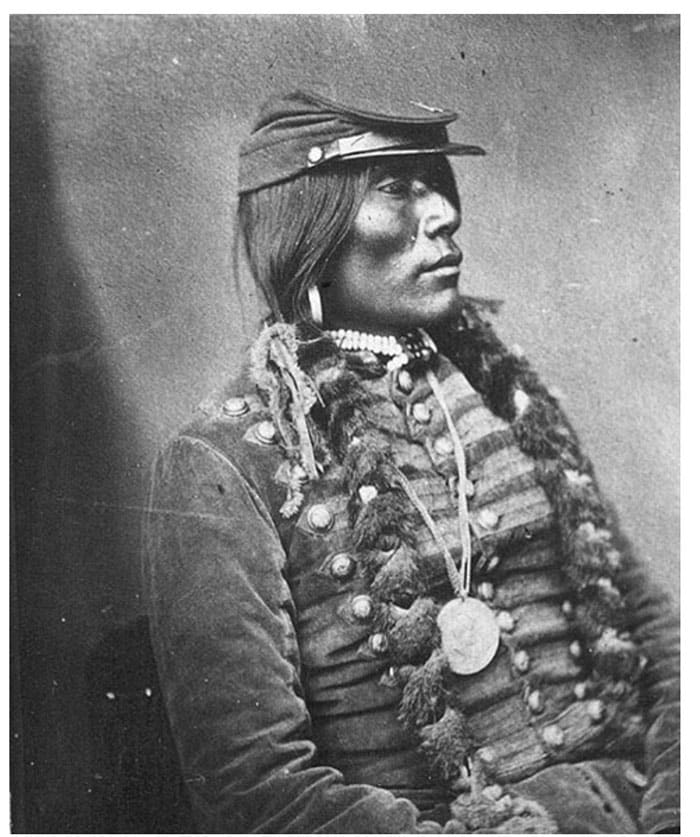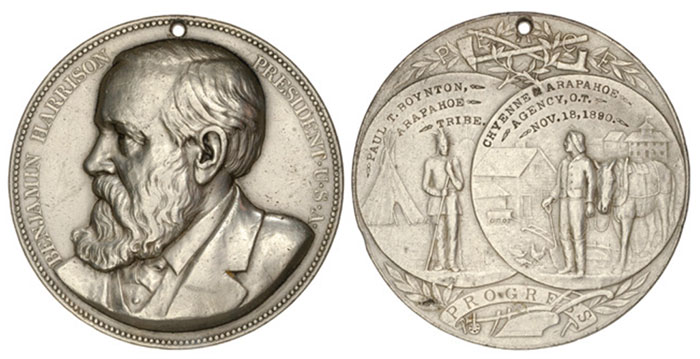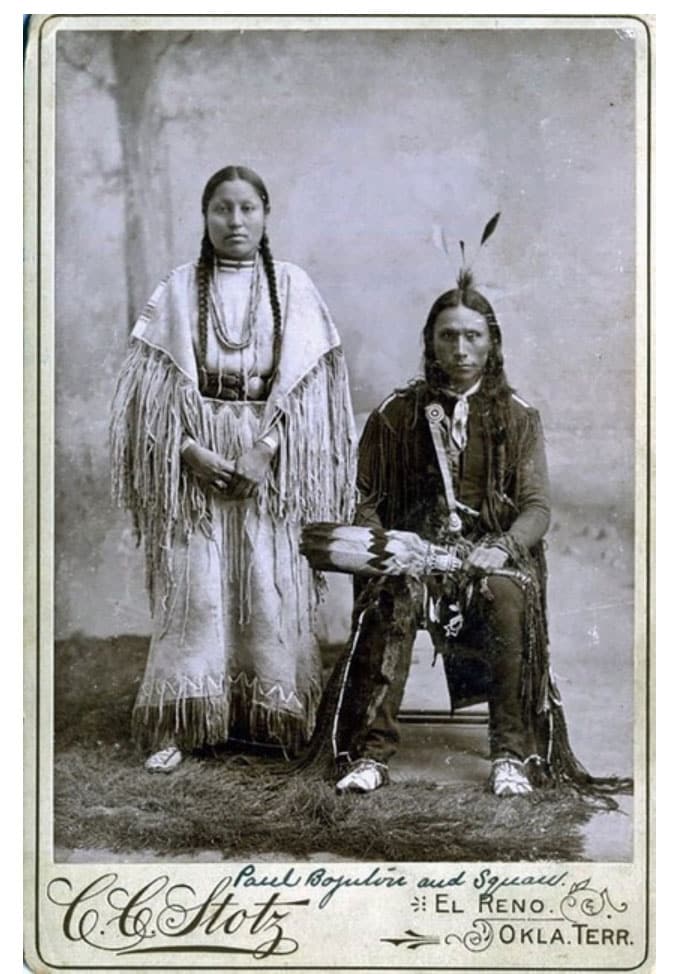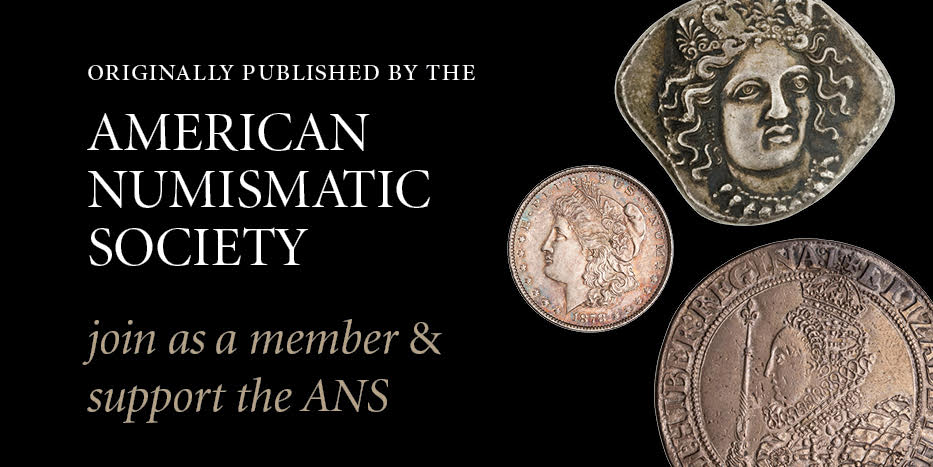By Oliver Hoover for American Numismatic Society (ANS) ……
The Dead Zone was a popular science fiction thriller written by Stephen King in 1979 that was made into a movie starring Christopher Walken in 1983. It tells the story of a man who discovers that he has the ability to see visions of the future when he touches objects that belong to another person. The Indian Peace Medal collection of the American Numismatic Society is kind of like that. When you work with these medals, look at them on a frequent basis, and have the opportunity to hold them in your hand, they never fail to call up visions of their original owners and of the specific pasts that they experienced.

Don’t get me wrong. Coins are great. The ANS is filled to the brim with coins that have fascinating stories to tell. However, except for specimens obtained straight from the Mint, most coins circulated through many hands in commerce before coming to rest in the Society’s collection, and most of those hands belong to nameless and faceless individuals.
The Indian Peace Medals are very different in this regard. They were given to specific people, many of whose names can still be found in various forms on U.S. and Canadian treaty documents of the 19th century. As such, the medals serve as relics for communing with their original Native American recipients and, in a few cases, the specific fur traders (John Lawe and Pierre Chouteau) who may have distributed them. The Indian Peace Medals in the collection are also especially powerful because, with the exception of a King George III medal very doubtfully associated with Tecumseh (Fig. 1), the vast majority that are attributed to their original owners by name are not linked to famous “great men”. None of the medals are said to have belonged to the larger-than-life figures of Black Hawk (Mahkate:wi-meši-ke:hke:hkwa), Sitting Bull (Tȟatȟáŋka Íyotake) or Crazy Horse (Tȟašúŋke Witkó). Instead, they belonged primarily to somewhat lesser flesh-and-blood leading men trying to negotiate futures for themselves and their people in a North America that was changing forever.


Perhaps the most famous Indian Peace Medal in the ANS collection with a recipient’s name attached to it is the large Abraham Lincoln medal that saved its owner from a gunshot (Fig. 2). It is said to have belonged to a 19th-century Ute (Núuchi) leader named Honkapkna (often reduced to Honko or Unco in contemporary sources) associated with the White River Ute Indian Agency in Colorado (Fig. 3).

He developed a negative reputation in Denver for his tendency to leave the reservation to hunt and fight with traditional enemies like the Cheyenne (Tsétsêhéstâhese). Contemporary newspapers also suspected him of attacking white settlers in areas where he had long hunted.
During a skirmish with Cheyenne warriors in 1873, Honkapkna was shot in the chest. Although the bullet should have killed him, it was stopped by his Lincoln medal and Honkapkna was only briefly knocked unconscious. While another man might have considered this an incredible stroke of luck, Honkapkna was disgusted. He had been under the impression that the medal had supernatural powers and should have prevented him from being shot at all. The next time he was in Denver, Honkapkna reportedly sold the medal to the gunsmith John P. Lower while complaining of its “bad medicine.”


Somewhat more unassuming is the Ulysses S. Grant medal attributed to Piah, a chief of the Nevava Ute band and associate of Honkapkna at the White River Agency (Figs. 4–5). Although it lacks the immediate drama of an embedded bullet, this medal has its own compelling and rather tragic story to tell.
The attribution of the medal to Piah seems fairly solid since his name is engraved around the edge with a worn date that should probably be read as 1873. He most likely received it following his signing of the Brunot Agreement on September 13, 1873. This treaty ceded the gold-rich San Juan Mountains within the great Ute reservation in return for annual payments of $25,000 in perpetuity.
In the years after signing the treaty, which he may not have understood in detail, Piah also developed a reputation similar to that of Honkapkna for the same reasons, as well as for his stated opposition to Ouray, the Uncompahgre (’Aka’-páa-gharʉrʉ) chief recognized by the United States as the head chief of all the Ute bands. Interestingly, the reports of his attacks on white miners and settlers increase dramatically in 1878, the year that Fredrick Pitkin was elected Governor of Colorado on a platform that emphasized the complete removal of the Ute from the state. In 1878, some newspapers even implicated him in the so-called Meeker Incident at the White River Agency, which involved the Ute defense of the reservation against elements of the U.S. Cavalry and the murder of the Indian agent, William Meeker. Piah was actually at the Los Piños Indian Agency at the time of the incident.
Upon learning of President Grant’s death, Piah is reported to have sold his medal in the belief that the supernatural powers he attributed to it also died along with the Great Father. It is unclear whether his decision to sell was influenced by Honkapkna’s earlier experience. The latter had been shot eight years after Lincoln was assassinated. According to the newspapers, not long after divesting himself of the medal, in early summer 1888, Piah reportedly died by suicide. Even if the Grant medal could have saved him from that fatal gunshot, no powers it may have possessed could have saved his people from the Dawes Act, which was passed the year before and was dedicated to the total assimilation of Native Americans as settled farmers and U.S. citizens.

A final example of an Indian Peace Medal in the collection that conjures the story of an individual through its attribution is a Benjamin Harrison medal given to the Arapaho (Hinono’eino) chief Paul T. Boynton (Figs. 6–7). The medal was presented to him on November 18, 1890, in recognition of his involvement in the implementation of the allotment system on the reservation and approval of the sale of the “surplus” land that remained to the U.S. Government for $1,500,000. Ironically, at the same time that Boynton was supporting the assimilationist requirements of the Dawes Act, he was also closely involved with the dissemination of the new Ghost Dance religion among the Southern Arapaho.
This religion, which originated with a Paiute (Numu) prophet in Nevada, advocated love, respect, and fair dealing among all Native American peoples and promised that if combined with this upright lifestyle, participation in the Ghost Dance would lead to the resurrection of dead ancestors, the return of the buffalo, and the return of white men to Europe. The Ghost Dance spread from Nevada to many distant reservations in large part through letters written and read by Native Americans who had received education in residential schools.
Paul Boynton’s original Arapaho name was Red Feather (Be’eekúúni’) but this was replaced by his Christian name when he was sent to the Carlisle Indian Industrial School at the age of 15. After eight years of training to read, write and work in the printing industry, he returned to the Cheyenne and Arapahoe Indian Agency in Oklahoma where he did clerical work for the agent. Thanks to his education, he was able to receive and pass on information about the Ghost Dance contained in letters from other reservations. He was himself an ardent believer in the dance and claimed to have seen his dead brother in an apparition.
Despite its largely pacifistic character and obvious Christian influences, the Ghost Dance made many U.S. Indian agents nervous. Fears that the Ghost Dance was a prelude to a general uprising resulted in the botched arrest and death of Sitting Bull at the Standing Rock Indian Agency in North Dakota and the infamous Wounded Knee Massacre at the Pine Ridge Agency in South Dakota, all in little more than a month after Boynton received his medal. Concerned that similar calamities could take place at the Cheyenne and Arapahoe Agency, Boynton took the time to clearly explain the purpose of the Ghost Dance to both the agent and to the ethnographer James Mooney in order to remove all possibilities of a terrible misunderstanding.
If Christopher Walken’s character had been alive in the late 1800s and had had the opportunity to touch any of these medals, we can imagine him animatedly warning their owners of the imminent breakage of the ice beneath their feet. Of course, he didn’t, and now it is left to us to take up the many Indian Peace Medals in the ANS collection and discover the visions of the past and of their original owners that they bring.
* * *






Your attempt to dramatize my grandfather’s life, would be better appreciated if you had actually taken appropriate measure to have your facts straight . If you would like to know the actual story of Paul Boynton I invite you to ask. What he lived through and did is far more impressive and important than you clearly know.